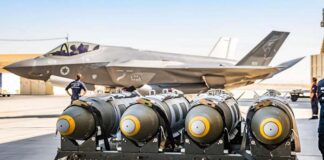Imperialist bullying by the US has pushed the Korean peninsula to the brink of nuclear war, not the actions of the North Korean regime.
The West blames the declarations from the North of an “all out war” and its threats to turn Seoul and Washington into a “sea of fire” for the tensions. But it is the escalation of US threats and sanctions against North Korea that have led to the current crisis. In January the UN Security Council imposed new sanctions on North Korea over its launch of a satellite last year. North Korea is the only country that the UN has denied the right to launch satellites.
In the wake of the leadership transition following former leader Kim Jong-Il’s death in December 2011, US war games and military preparations have also taken a more aggressive tone. Annual military exercises involving South Korean and US troops last year simulated a pre-emptive attack on the North.

One of South Korea’s top generals warned it would launch a pre-emptive strike if there was any chance of a nuclear attack from the North. It is estimated at least one million people would die in such an attack. North Korea countered this by conducting its third nuclear test in February.
US officials now claim they are trying to defuse tensions in the region. But their response to the test was to move ahead with war games involving 20,000 US troops. These included B-52 bombers and nuclear-capable B-2 stealth bombers that simulated nuclear strike missions on North Korea.
The US also sees the ongoing demonisation of North Korea as a way to justify its presence in Asia as part of its “pivot” to the region aimed at encircling China. It has used the current crisis as an excuse to move a missile defence shield to the Pacific island of Guam earlier than planned. It wants to increase the military build up among allies like Japan and South Korea and tie them further into defence co-operation with the US.
State of war
The Korean peninsula has remained officially at war since the Korean war of 1950-53. Even today 28,500 US military personnel remain there in over 40 military bases. The division into North and South Korea was a product of the Cold War, with the North backed by Russia and the South by the US.
Since the early 1990s the North Korean economy has been in a state of collapse due to the loss of its old sponsor, the Soviet Union. It suffered widespread famine, and food shortages still continue.
Lacking reserves of energy, the North has had nuclear power plants since 1974.
In the 1990s, the regime hit on the idea of developing a nuclear weapons program as a bargaining chip to try to extract aid and concessions from the West.
In exchange for North Korea disbanding its weapons program, the US agreed in 1994 to help build two new proliferation resistant nuclear reactors and provide food and oil aid. There was also agreement to move towards full normalisation of political relations and end the sanctions that had continued since the end of the Korean war. But the US never kept its side of the bargain. The reactors were never completed and the US refused to drop its sanctions on the country.
Axis of evil?
When North Korea was included on George Bush’s “axis of evil” and threatened with invasion, it became clear that nuclear weapons at least provided the country with a safeguard against attack. Now the US is confronted with the reality that North Korea has built a stockpile of nuclear weapons, although it does not yet have the proven missile capacity to target them at the US.
The US by contrast has a high-tech nuclear weapons arsenal of 4500 warheads, and remains the only country to have used nuclear weapons in war.
The North Korean regime is a dictatorship that has nothing to do with socialism. It is appalling that such a poor country wastes such huge sums on its military and nuclear weapons. But it is the bullying of the US, the world’s sole superpower, that is responsible for this crisis.
James Supple





